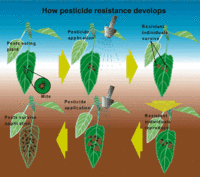-
Aircraft used in Vietnam source of postwar Agent Orange contamination in U.S.

During the Vietnam War, in an operation called Operation Ranch Hand, approximately twenty million gallons of herbicides, including around 10.5 million gallons of dioxin-contaminated Agent Orange, were sprayed by about thirty-four C-123 aircraft. These aircraft were subsequently returned to the United States and were used by Air Force reserve units between 1971 and 1982 for transport operations. Air Force reservists who flew these planes were exposed greater levels of dioxin than previously acknowledged.
-
-
Visually displayed early warning system for epidemics
Cholera has been all but eradicated in Europe, but this bacterial, primarily waterborne disease still claims thousands of lives in Africa every year. In an EU-funded project, scientists are examining the effects various environmental factors have on cholera epidemics in Uganda, and have developed a software architecture for early warning systems that compares environmental and health data and presents the results graphically, allowing for the creation of visually displayed early warnings of epidemic breakouts.
-
-
Uncovering drug resistance mechanism to help development of antibiotic drug candidates
The use of antibiotics is often considered among the most important advances in the treatment of human disease. Unfortunately, though, bacteria are finding ways to make a comeback. More than two million people in the United States come down with antibiotic-resistant infections annually, and at least 23,000 die because their treatment cannot stop the infection. A new study has uncovered a mechanism of drug resistance. This knowledge could have a major impact on the development of a pair of highly potent new antibiotic drug candidates.
-
-
Superbugs presence increases during annual pilgrimage to India’s sacred sites

The spread of antibiotic-resistance to one of the most pristine locations in Asia is linked to the annual human pilgrimages to the region, new research has shown. The researchers have found that in May and June, when hundreds of thousands of visitors travel to Rishikesh and Haridwar to visit sacred sites, levels of resistance genes that lead to “superbugs” were found to be about sixty times greater than other times of the year. They argue that preventing the spread of resistance genes that promote life-threating bacteria could be achieved by improving waste management at key pilgrimage sites.
-
-
Solution to drug resistance problem receives U.S. patent
Before the development of penicillin, people dropped like flies in response to minor infections. Even pimples could grow to boils that killed. One of the main killers prior to the discovery of antibiotics was tuberculosis. The deadly infectious disease that typically affects the lungs has returned – and has developed a resistance to the majority of antibiotics that would otherwise kill the tuberculosis bacteria. A Danish chemistry researcher has taken out a patent for a drug that can make previously multidrug-resistant bacteria once again responsive to antibiotics.
-
-
Gaining better understanding of tularemia, aka “rabbit fever”
Tularemia, aka “rabbit fever,” is endemic in the northeastern United States, and is considered to be a significant risk to biosecurity — much like anthrax or smallpox — because it has already been weaponized in various regions of the world. Despite its importance for both public health and biodefense, F. tularensis pathogenesis is not entirely understood, nor is it fully understood how the organism persists in the environment.
-
-
Resistance shapes the discovery of new insecticides

Recent news around the world has focused on the dangers of antibiotic resistance. – and the CDC estimates over two-million illnesses and 23,000 deaths occurred in 2013 as a result of antibiotic resistance in bacteria and fungus. But what of another type of resistance which can also have a huge impact on the population: that to insecticides? Livestock, for example, are affected by buffalo flies; farmers and customers are familiar with the total devastation caused by fruit flies; malaria mosquitoes and bed bugs are becoming more resistant to existing chemicals. Even our pets are affected: fleas and ticks are continuing their march, leading to a need for newer, often more expensive synthetic chemistries. The price of insecticide resistance — in the form of R&D costs for new compounds — is passed from chemical companies, to farmers, to consumers.
-
-
Long-term perspective on food security and climate shock
What role do pre-existing vulnerabilities play for people who experience a climate shock? Do these vulnerabilities amplify the effects of the climate shock or is effect negligible? Four Arizona State University archaeologists are looking into this as part of an international team examining how people can be most resilient to climate change when it comes to food security.
-
-
Research on bacteria-invading virus to help the agriculture community

Innovative work by two Florida State University scientists shows the structural and DNA breakdown of a bacteria-invading virus. This type of virus is called a bacteriophage, and the deconstruction of its DNA could be particularly useful for the agriculture community and seed companies. Important crop plants depend on biological nitrogen fixation by the bacteria which is preyed upon by this phage. Nitrogen fixation is the process by which abundant nitrogen gas in the atmosphere is converted to the scarce soil resources ammonia and nitrate.
-
-
W.Va. spill leads lawmakers, industry to look at reforming toxic substances law
The government was slow to respond to the 9 January 2014 massive chemical spill in West Virginia because the law governing such response, the 1976 Toxic Substances Control Act (TSCA), limits regulatory agencies’ authority to investigate such spills.Under TSCA, the EPA must first prove that a chemical poses an unreasonable risk to health or the environment before it can require the needed testing that would show a potential risk. One observer called this a Catch-22, telling a congressional panel that “This is like requiring a doctor to prove that a patient has cancer before being able to order a biopsy.”
-
-
Floods caused lead poisoning in U.K. cattle
Massive floods in England and Wales have forced thousands to evacuate their homes and destroyed railways and roads. Scientists say the U.K. floods of recent years carry yet another danger with them: lead poisoning. Silage cut from fields soon after they were inundated in the 2012 floods and then fed to cattle raised the lead levels in the animals, killing some of them. Blood samples taken from cattle showed that all of them had lead levels beyond the safe limit for human consumption. An autopsy carried out on one of the casualty animals found lead concentrations 79 times the safe level in its kidney. The contaminated material is thought to originate from historical metal mining in the area. Scientists say a number of river catchments throughout England and Wales face a similar risk.
-
-
North Carolina brain surgery patients exposed to deadly disease
Officials at a North Carolina hospital last Tuesday notified eighteen patients that they might have been exposed to Creutzfeldt-Jakob disease (CJD), a degenerative brain disease which is always fatal and which makes those infected exhibit symptoms of dementia before they die. The eighteen patients had brain surgery performed on them since 18 January. A patient operated on that that day was subsequently tested positive for the disease. The hospital said that the surgical instruments used on the patient with CJD were sterilized, but were “not subjected to enhanced sterilization procedures.’
-
-
Real-time livestock disease situational awareness
Veterinarians are the U.A. first responders for animal health, acting as the primary line of defense against animal disease outbreaks and are essential to the protection of our animal industries and economy. Researchers at the National Center for Foreign Animal and Zoonotic Disease Defense (FAZD Center) are working with veterinarians, federal and state animal health officials, and industry partners to improve real-time situational awareness of animal diseases.
-
-
More than 60 percent of California suffers drought conditions, with no relief in sight

The entire west coast of the United States is changing color as the deepest drought in more than a century unfolds. According to the U.S. Department of Agriculture and NOAA, dry conditions have become extreme across more than 62 percent of California’s land area — and there is little relief in sight. “Up and down California, from Oregon to Mexico, it’s dry as a bone,” say a NAA scientist. “To make matters worse, the snowpack in the water-storing Sierras is less than 20 percent of normal for this time of the year.”
-
-
Security of dirty bomb materials in U.S. inadequate: experts
There are more than 5,000 medical and research devices in the United States containing high-activity radiation sources, including 700 with category-1 sources. Category-1 radiation material could be used by terrorists in dirty bombs. The security measures developed by the industry were written with accident prevention in mind, not in order to thwart a deliberate, forcible effort by terrorists or criminals to gain control of the toxic material. In addition, radioactive materials were considered to be “self-protecting,” because it was assumed that the powerful radiation would deter anyone thinking of tampering with these devices. Terrorist bomb-makers, however, showed themselves to be more technologically-savvy than earlier thought, and, in any event, suicide bombers would not be deterred by the risk of radiation poisoning.
-
More headlines
The long view
We Ran the C.D.C.: Kennedy Is Endangering Every American’s Health
Nine former leaders of the Centers for Disease Control and Prevention (CDC), who served as directors or acting directors under Republican and Democratic administrations, serving under presidents from Jimmy Carter to Donald Trrump, argue that HHS Secretary Roert F. Kennedy Jr. poses a clear and present danger to the health of Americans. He has placed anti-vaxxers and conspiracy theorists at top HHS positions, and he appears to be guided by a hostility to science and a belief in bizarre, unscientific approaches to public health.
